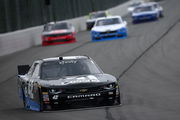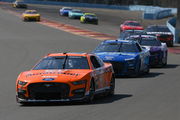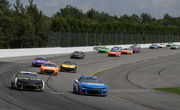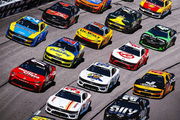
via Imago
NASCAR, Motorsport, USA O Reilly Auto Parts 300 Apr 8, 2016 Fort Worth, TX, USA Team owner Joe Gibbs before the O Reilly Auto Parts 300 at Texas Motor Speedway. Fort Worth Texas Motor Speedway TX USA, EDITORIAL USE ONLY PUBLICATIONxINxGERxSUIxAUTxONLY Copyright: xJeromexMironx 9237797

via Imago
NASCAR, Motorsport, USA O Reilly Auto Parts 300 Apr 8, 2016 Fort Worth, TX, USA Team owner Joe Gibbs before the O Reilly Auto Parts 300 at Texas Motor Speedway. Fort Worth Texas Motor Speedway TX USA, EDITORIAL USE ONLY PUBLICATIONxINxGERxSUIxAUTxONLY Copyright: xJeromexMironx 9237797
The introduction of next-generation cars marked a transformative chapter in NASCAR’s history. This model was lauded not just by the drivers but also by spectators and pundits for its superior speed, state-of-the-art technological features, and aerodynamic prowess. Yet, despite its triumphant entry, it didn’t manage to replicate the same exhilaration on short tracks as its predecessors did.
NASCAR, in its unwavering commitment to excellence, has undertaken rigorous efforts to rectify these short-track challenges, experimenting with various components, including the front splitter. Yet, according to the drivers’ consensus, the experience remains unchanged. Even now, fervent discussions continue, with many, including the prodigy of Joe Gibbs, championing the return of the electrifying entertainment once synonymous with the Gen-6 era on short tracks.
ADVERTISEMENT
Article continues below this ad
The Joe Gibbs driver tried but failed at short tracks
The revered short tracks like Richmond, Martinsville Speedway, and Bristol Motor Speedway have jointly hosted nearly 400 Cup Series races, much to the delight of fans who relish the adrenaline-packed racing marked by inevitable car contacts and heightened driver emotions.
However, with the inclusion of next-generation cars, the tracks have, to an extent, lost their charm. For instance, Richmond especially rose to prominence in 2004, when it was designated the finale of the regular season. This was in sync with NASCAR’s unveiling of the “Chase” points system, the new blueprint to crown the Cup Series champion. For a commendable stretch, Richmond held this crucial spot alongside a spring race until a 2019 reshuffle by NASCAR relocated the Richmond race within the playoff frame. Regrettably, the once electrifying ambiance of “The Action Track” waned, compelling NASCAR to reposition the 2022 fall race further up the calendar.
Despite myriad changes and the unveiling of tailored short-track packages, the vivacity of short-track racing remains seemingly unchanged. The sentiment was recently reiterated by Christopher Bell, the young maestro of Joe Gibbs Racing. When prodded by a former HMS associate about potential solutions to the less-than-spectacular short-track events, a perplexed Bell admitted, “I don’t know. Like I remember going to Phoenix for a short-track test, and I would have put my heart and soul. That little spoiler was going to make it better. And as it turns out, it really didn’t.”
He went on to express his initial optimism about the changes, emphasizing his genuine belief in their potential. “I was all in at that test in January whenever we back to back it. I swore to you, I could get closer to the guy in front of me, and I thought I was going to be better.”
Watch This Story: NASCAR’s 2024 Schedule: A New Chapter Begins
It’s apparent that the Next-Gen car’s prowess dwindles on short tracks, a vulnerability that shows no sign of amelioration. Even the Cup Series’ subsequent Martinsville foray garnered lukewarm feedback. The pressing question now remains: What is the remedy? Whether it demands augmented horsepower, a fresh aerodynamic blueprint, or a radical car overhaul, something must shift, as the present short-track races appear to be lacking the former spark. Yet, amidst the short-track conundrums with the next-gen car, NASCAR has intriguingly introduced a fresh short (nearly intermediate) track to the 2024 itinerary.
ADVERTISEMENT
Article continues below this ad
Trending
NASCAR adds a new track to its 2024 schedule
In an exciting development for 2024, NASCAR’s Cup Series unveils a fresh addition to its race circuit, with the Iowa Speedway slated for June 16. The race weekend, spanning from June 14–16, will supersede the slot previously held by California Speedway. While there had been deliberations around transforming the 2-mile Fontana track into a short circuit, the idea hadn’t materialized. Instead, a portion of the land was earmarked for parking purposes.
Reflecting on this development, Ben Kennedy, NASCAR’s Senior Vice President of Racing Development and Strategy, shared his insights with NASCAR.com. He articulated, “We talk a lot about the racing product and what that looks like, and we hear from a lot of our fans who would like to see more short tracks. And then we also hear how good intermediate racing is with this Next Gen car. And I think Iowa, in a lot of ways, shows both the short track as well as an intermediate race track in the way that it races. I’m so excited to see it on the schedule.”
ADVERTISEMENT
Article continues below this ad
While the anticipation builds, fans and aficionados alike are ardently hoping for NASCAR to refine their short-track packages. The aspiration? Rekindling the unparalleled fervor once synonymous with iconic venues like Martinsville and Richmond.
ADVERTISEMENT
ADVERTISEMENT
ADVERTISEMENT
ADVERTISEMENT






